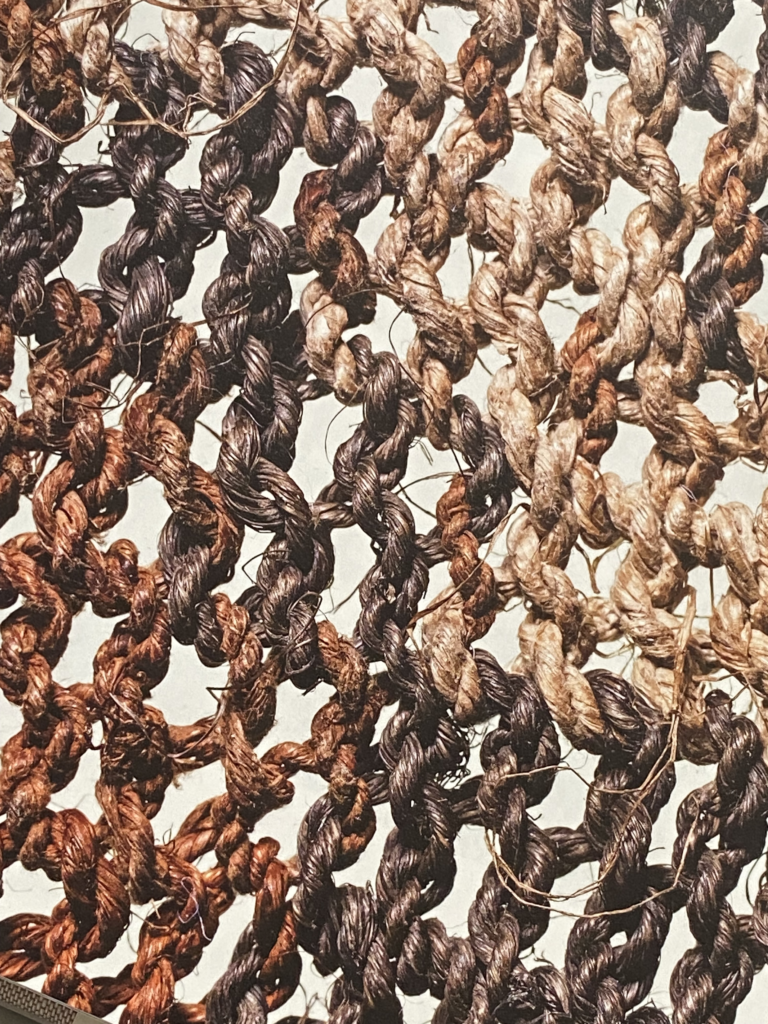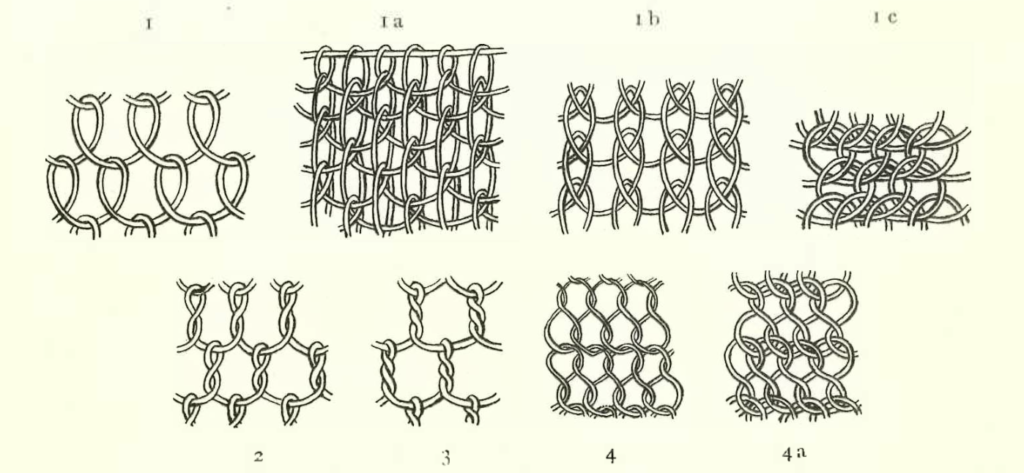
Source: Photo Alex Pillen of Albers 2017, plate 46, detail of ancient looped bag, Salta, northern Argentina
Materials and techniques to approach an architecture of language need careful consideration. Methods of visualization of natural language seem like guide rails into the blindness of an as yet un-realized dimension. The conceptual and material elements of such an installation could be one more guide rail for chunks of natural language to reveal their organic shape.

Source: Graebner 1913, p. 26
In order to learn to shape the intricate details of language, I experimented with metal wires between 0.2 and 1mm (copper, brass, gilt on copper, bronze). Deducting shapes from language recordings and rendering them with wire, allows for the construction of layers. It is this see-through quality of a wire mesh that I am after. I needed wires for the shapes and a knotless technique for the wires. For a knot a piece of string or rope is looped on itself and then tightened, fixed into place. To sculpt language with thin wires I need fluidity, a chance to adjust patterns that then exert an effect on their immediate vicinity. I decided to go knotless.

Source: Davidson 1935, p. 121
An acknowledgment of colonial encounters is central to anthropology as it is practiced today. Such an acknowledgment also permeates my material practice. I searched the early ethnographic literature and found material on knotless netting from 1913, 1924, and 1935. My colleague Ludo Coupaye suggested a series of more contemporary references on string bags and ligatures. In this transition from one semiotic domain to another, as I transduce chunks of natural language, I would like to experiment with knotless wire netting. Many of these techniques have now become part of our global culture, but we should not lose sight of the cultural specificity of their origins.

Source: Photo Alex Pillen of Albers 2017, plate 45, Lace, ancient Peru
References
Albers, A. (2017). Tactile sensibility. In On weaving. New Expanded edition. Princeton and Oxford: Princeton University Press.
Plate 45
Davidson, D.S. (1935). Knotless netting in America and Oceania. American Anthropologist 37(1): 117-134.
pp. 120-122
Evans R (1997) Translations from drawing to building and other essays. Architectural Association Publications, London
p.173
Graebner, F. 1913 Taschen und Körbe in der Südsee. Ethnologica 2(1), Leipzig.
p.26
Roth, W.E. 1924 An introductory study of the arts and crafts and customs of the Guiana Indians. 38th Annual report: Bureau of American Ethnology.
Silverstein, M. (2003). Translation, transduction, transformation: Skating ‘glossando’ on thin semiotic ice. In P. Rubel & A. Rosman (Eds.), Translating cultures: Perspectives on translation and anthropology (pp. 75-108). Berg.
From Ludo:
Buck, Peter (Te Rangi Hiroa). 1944. Arts and Crafts of the Cook Islands. Honolulu: Bernice P. Bishop Museum, Bulletin 122
Hauser-Schäublin, Brigitta. 1996. The Thrill of the Line, the String, and the Frond, or why the Abelam is a non-cloth culture. Oceania, 67 (2): 81-106.
Ingold, Tim. 2000. Of String Bags and Birds. In The Perception of the Environment: Essays on Livelihood, Dwelling and Skill. London: Routledge: 349-361.
Mackenzie, Maureen A. 1991. Androgynous Objects: String Bags and Gender in Central New Guinea. Chur, Switzerland & Reading: Harwood Academic.